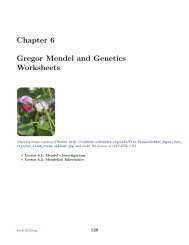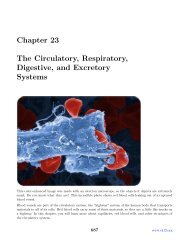Life Cycle of Seedless Vascular Plants - Wikispaces
Life Cycle of Seedless Vascular Plants - Wikispaces
Life Cycle of Seedless Vascular Plants - Wikispaces
You also want an ePaper? Increase the reach of your titles
YUMPU automatically turns print PDFs into web optimized ePapers that Google loves.
many epiphytes have evolved modified leaves or other structures for collecting rainwater, fog, or dew. Theleaves <strong>of</strong> the bromeliad shown in Figure 16.26 are rolled into funnel shapes to collect rainwater. Thebase <strong>of</strong> the leaves forms a tank that can hold more than 8 liters (2 gallons) <strong>of</strong> water. Some insects andamphibians may spend their whole life cycle in the pool <strong>of</strong> water in the tank, adding minerals to the waterwith their wastes. The tissues at the base <strong>of</strong> the leaf are absorbent, so they can take in both water andminerals from the tank.Figure 16.26: The leaves <strong>of</strong> this bromeliad are specialized to collect, store, and absorb rainwater.Plant ResponsesLike all organisms, plants detect and respond to stimuli in their environment. Unlike animals, plants can’trun, fly, or swim toward food or away from danger. They are usually rooted to the soil. Instead, a plant’sprimary means <strong>of</strong> response is to change how it is growing. <strong>Plants</strong> also don’t have a nervous system tocontrol their responses. Instead, their responses are generally controlled by hormones, which are chemicalmessenger molecules.Plant TropismsAs you read earlier in this chapter, plant roots always grow downward because specialized cells in rootcaps detect and respond to gravity. This is an example <strong>of</strong> a tropism. A tropism is a turning toward oraway from a stimulus in the environment. Growing toward gravity is called geotropism. <strong>Plants</strong> also exhibitphototropism, or growing toward a light source. This response is controlled by a plant growth hormonecalled auxin. As shown in Figure 16.27, auxin stimulates cells on the dark side <strong>of</strong> a plant to grow longer.This causes the plant to bend toward the light.www.ck12.org 436





